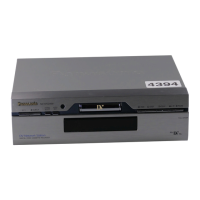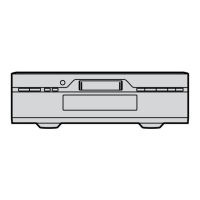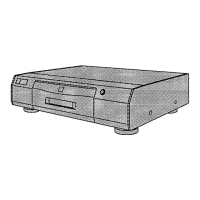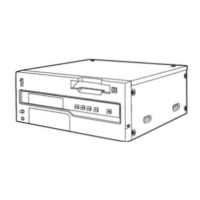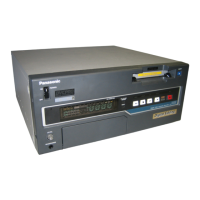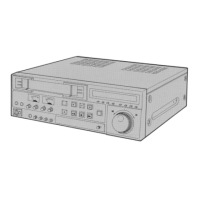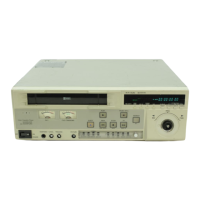Do you have a question about the Panasonic DVCPRO50 AJ-D960EG and is the answer not in the manual?
Detailed steps for safely replacing the fuse in the AC mains lead.
Overview of the unit's capabilities including size, recording time, picture quality, and interfaces.
Details on serial digital, analog video, AES/EBU audio, SDTI, and remote control interfaces.
Introduction to the front panel layout, including power and system display controls.
Explanation of input selection switches and the corresponding display indicators for video and audio signals.
Details on buttons for tape movement, playback, recording, and status indicators like SERVO and REC INHIBIT.
Covers time code settings, interface selection, and mode switching controls like TAPE/EE and INT/EXT.
Explains the search dial, shuttle switch, and various status lamps on the front panel.
Describes buttons for editing operations, preview, review, and cue point management.
Details various indicator lamps, level meters, and audio input/output level adjustment controls.
Covers volume control for headphones/monitor, audio monitor channel selection, and meter scale adjustment.
Details video, chroma, black level, phase controls, CF switch, and TC generator settings.
Explains REC INHIBIT, TV SYSTEM selection, MENU, SET, and DIAG buttons.
Introduces the various input and output connectors located on the rear panel of the unit.
Lists and describes the analog and digital video and audio input/output connectors.
Lists and describes digital, remote control, RS-232C, and parallel interface connectors.
Diagram and instructions for connecting a single unit to external devices.
Diagram and instructions for connecting two units for deck-to-deck operation.
Diagram illustrating connections for operating with an external editing controller.
Diagram for connecting units to adjust video output (encoder output) signals.
Information on compatible tape types (S, M, L sizes) and precautions for consumer DV/DVCAM tapes.
How to use the search dial in jog mode for variable speed playback.
Using the search dial and switch for shuttle or slow-speed playback.
Basic steps for performing automatic editing between two decks.
Configuration of recorder and player units for automatic editing.
Choosing between Assemble and Insert editing modes.
Procedure for setting IN and OUT points for editing operations.
How to verify and adjust entered edit points and calculate duration.
Performing a preview of the edit and executing the automatic editing process.
Playing back the result after automatic editing is completed.
Details on setting, deleting, modifying, and displaying audio split edit points.
Step-by-step guides for performing internal voice-over editing.
Instructions for performing voice-over editing using an external AG-A850 controller.
Details on connecting and performing audio cross channel editing.
Explanation of the multi cue display format and fundamental operations.
Detailed procedures for entering, clearing, and managing cue points.
Procedure for accessing and modifying default setup menu items.
Details on managing user files, system settings, and various menu categories.
Configuration options for system-level parameters like video output and synchronization.
Configuration options for user-specific settings across BASIC, OPERATION, INTERFACE, EDIT, etc.
Steps for configuring and recording the unit's internal time code.
Procedure for selecting and using external LTC or VITC time codes.
How video output signals synchronize with REF VIDEO or input video signals.
Determining the servo reference signal based on input availability and settings.
Configuring which audio input signals are recorded onto specific tracks.
Selecting which audio signals are output to the monitor L/R channels.
Information on the auto head cleaning function and recommendations.
Guidance on preventing and handling condensation issues within the unit.
Instructions for installing the mechanism dust protector.
How to access the DIAG menu for VCR information and warning messages.
Details on displaying and resetting operational time information.
Lists potential warnings, their descriptions, and VTR operational status.
Comprehensive table of AUTO OFF errors, their causes, and recovery actions.
Details on connector specifications and PC connection examples.
Information on communication parameters, send/return formats, and protocol.
List of RS-232C error codes and command tables for operation and inquiries.
Instructions for using SDTI and SDI signals as inputs.
Instructions for selecting SDTI or SDI signals for output.
How to operate in the 2x speed transmission mode for SDTI output.
Important notes and precautions to observe when using SDTI signals.
Physical and environmental specifications including power, weight, and dimensions.
Technical details for video signals, sampling frequencies, compression, and bit rates.
Technical details for audio signals, connectors, and input/output levels.

